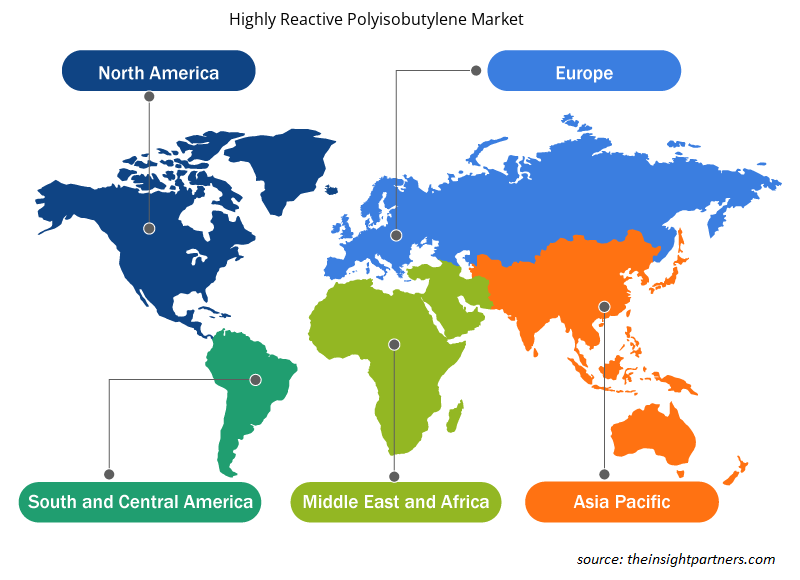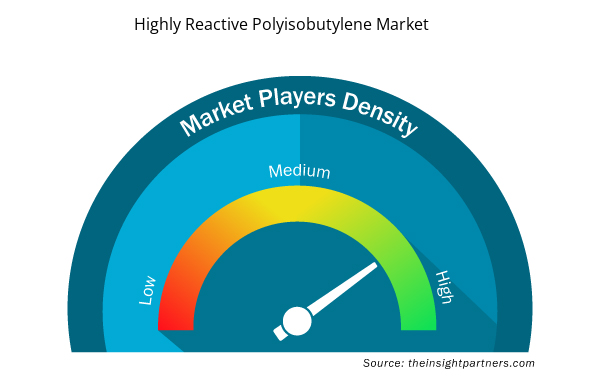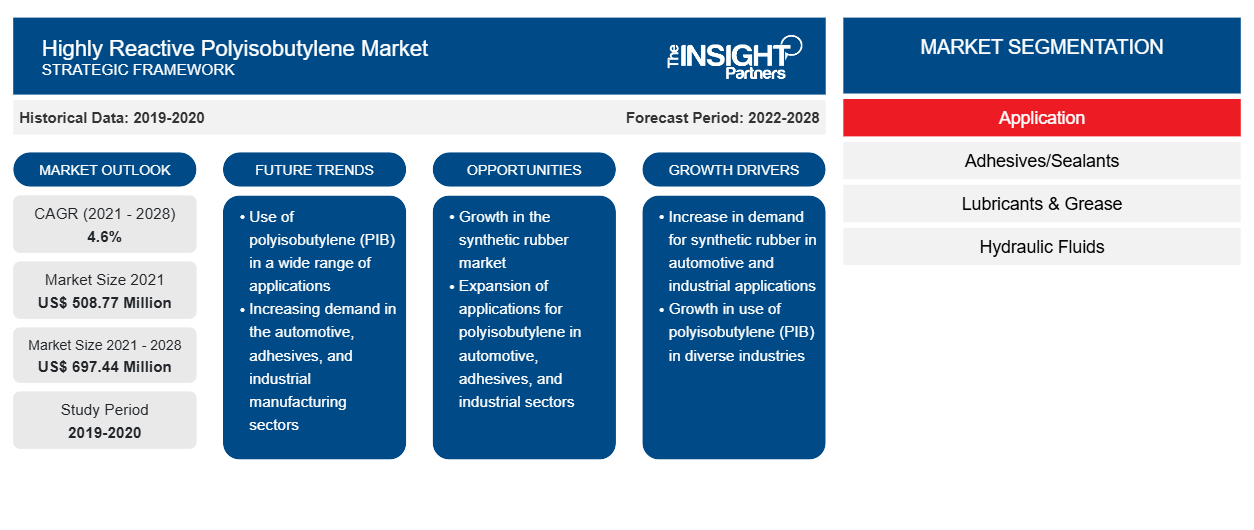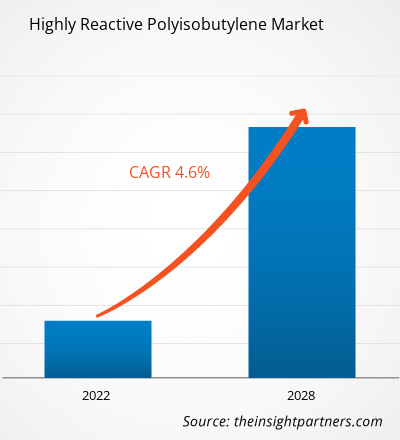Der Markt für hochreaktives Polyisobutylen soll von 508,77 Millionen US-Dollar im Jahr 2021 auf 697,44 Millionen US-Dollar im Jahr 2028 anwachsen; von 2021 bis 2028 wird mit einer durchschnittlichen jährlichen Wachstumsrate von 4,6 % gerechnet.
Hochreaktives Polyisobutylen (HR-PIB) ist ein wichtiges Zwischenprodukt bei der Herstellung von leistungsstarken Kraftstoff- und Schmierstoffadditiven, wie beispielsweise Dispergiermitteln für Motoröle oder Kraftstoffreinigern. Die Hochleistungs-Schmierstoffadditive ermöglichen eine kraftstoffeffizientere Motorkonstruktion.
Im Jahr 2020 hatte der asiatisch-pazifische Raum den größten Umsatzanteil am Markt für hochreaktives Polyisobutylen . Das Segment Schmierstoffe und Fette ist der größte Verbraucher von HR-PIB im asiatisch-pazifischen Raum. Die Verbreitung des Automobilsektors in der Region steigert die Nachfrage nach Hydraulikflüssigkeiten und Schmierstoffen und treibt damit den Bedarf an HR-PIB an. Darüber hinaus treibt die zunehmende Industrialisierung und Bauwirtschaft im asiatisch-pazifischen Raum die Nachfrage nach Maschinen und Ausrüstung in den entsprechenden Produktionsstätten an.
Passen Sie diesen Bericht Ihren Anforderungen an
Sie erhalten kostenlose Anpassungen an jedem Bericht, einschließlich Teilen dieses Berichts oder einer Analyse auf Länderebene, eines Excel-Datenpakets sowie tolle Angebote und Rabatte für Start-ups und Universitäten.
- Holen Sie sich die wichtigsten Markttrends aus diesem Bericht.Dieses KOSTENLOSE Beispiel umfasst eine Datenanalyse von Markttrends bis hin zu Schätzungen und Prognosen.
Auswirkungen der COVID-19-Pandemie auf den Markt für hochreaktives Polyisobutylen
Im Jahr 2020 mussten verschiedene Branchen ihre Produktion aufgrund von Lieferkettenunterbrechungen aufgrund der Schließung nationaler und internationaler Grenzen drosseln, was zu einer geringen Nachfrage nach HR-PIB führte. Die Pandemie verursachte Störungen in den Herstellungsprozessen aufgrund von Beschränkungen, die von Regierungsbehörden in verschiedenen Ländern hinsichtlich der Mitarbeiterzahl in den Werken und des Transports verhängt wurden, was es für die Mitarbeiter schwierig machte, zu den Arbeitsstätten und wieder nach Hause zu pendeln. HR-PIB findet wichtige Anwendung bei der Herstellung von Hochleistungs-Kraftstoff- und Schmierstoffzusätzen. Die gesunkene Nachfrage nach Kraftstoff aus verschiedenen Branchen behinderte den Verbrauch von Kraftstoffzusätzen und behinderte schließlich den Verkauf von HR-PIB. Als die Volkswirtschaften jedoch im Jahr 2021 begannen, ihren Betrieb wieder anzukurbeln, begann auch die Nachfrage nach HR-PIB allmählich zu steigen.
Markteinblicke
Zunehmender Einsatz von HR-PIB bei der Herstellung von Hochleistungsadditiven für Kraftstoffe und Schmiermittel
HR-PIB ist ein wichtiges Zwischenprodukt, das bei der Herstellung von Hochleistungs-Kraftstoff- und Schmierstoffadditiven Anwendung findet . Aufgrund seiner hohen Reaktivität wird es bei der Herstellung von Additiven herkömmlichem Polyisobutylen vorgezogen. Die Hauptfunktion von Schmierstoffadditiven besteht darin, die Eigenschaften des Grundöls unter verschiedenen Betriebsbedingungen zu verbessern. Darüber hinaus unterstützen Hochleistungs-Schmierstoffadditive kraftstoffeffizientere Motorkonstruktionen. Dispergiermittel sind Schmierstoffadditive, die dabei helfen, die Bildung von Schlamm, Lack und anderen Ablagerungen auf kritischen Oberflächen zu verhindern. Die Nachfrage nach HR-PIB wächst bei der industriellen Synthese von Dispergiermitteln für Motoröle für Kraftfahrzeuge. Die Präsenz starker additiver Fertigungsstandorte in den USA, Europa und im asiatisch-pazifischen Raum macht diese zu Hauptabnehmern von HR-PIB. Daher fördert die zunehmende Verwendung von HR-PIB bei der Herstellung von Hochleistungs-Kraftstoff- und Schmierstoffadditiven das Marktwachstum.
Anwendungseinblicke
Basierend auf der Anwendung wurde der Markt für hochreaktives Polyisobutylen in Klebstoffe/Dichtstoffe, Schmiermittel und Fette, Hydraulikflüssigkeiten, Metallbearbeitungsflüssigkeiten und andere unterteilt. Das Segment Schmiermittel und Fette hatte im Jahr 2020 den größten Marktanteil. Schmiermittel wie Motoröle, Getriebeöle, Schmierfette und Kompressoröle werden in der Automobil-, Flugzeug-, Schiffs- und Maschinenbauindustrie stark verbraucht. HR-PIB trägt dazu bei, die Gesamtleistung von Schmiermitteln zu verbessern.
TPC Group; RB PRODUCTS INC.; BASF PETRONAS Chemicals Sdn. Bhd; Shandong Hongrui New Material Technology Co., Ltd; Daelim Co., Ltd.; Chevron Corporation; The Lubrizol Corporation; KEMAT Polybutenes; Weifang Binhai Petro-chem Co., Ltd.; und Nelson Brothers Incorporated gehören zu den wichtigsten Marktteilnehmern auf dem Markt für hochreaktives Polyisobutylen. Akteure auf dem Markt für hochreaktives Polyisobutylen konzentrieren sich stark auf die Entwicklung hochwertiger und innovativer Produkte, um die Anforderungen der Kunden zu erfüllen.
Regionale Einblicke in den Markt für hochreaktives Polyisobutylen
Die regionalen Trends und Faktoren, die den Markt für hochreaktives Polyisobutylen im gesamten Prognosezeitraum beeinflussen, wurden von den Analysten von Insight Partners ausführlich erläutert. In diesem Abschnitt werden auch die Marktsegmente und die Geografie für hochreaktives Polyisobutylen in Nordamerika, Europa, im asiatisch-pazifischen Raum, im Nahen Osten und Afrika sowie in Süd- und Mittelamerika erörtert.

- Erhalten Sie regionalspezifische Daten zum Markt für hochreaktives Polyisobutylen
Umfang des Marktberichts über hochreaktives Polyisobutylen
| Berichtsattribut | Details |
|---|---|
| Marktgröße im Jahr 2021 | 508,77 Millionen US-Dollar |
| Marktgröße bis 2028 | 697,44 Millionen US-Dollar |
| Globale CAGR (2021 - 2028) | 4,6 % |
| Historische Daten | 2019-2020 |
| Prognosezeitraum | 2022–2028 |
| Abgedeckte Segmente | Nach Anwendung
|
| Abgedeckte Regionen und Länder | Nordamerika
|
| Marktführer und wichtige Unternehmensprofile |
|
Dichte der Marktteilnehmer für hochreaktives Polyisobutylen: Auswirkungen auf die Geschäftsdynamik verstehen
Der Markt für hochreaktives Polyisobutylen wächst rasant, angetrieben durch die steigende Nachfrage der Endverbraucher aufgrund von Faktoren wie sich entwickelnden Verbraucherpräferenzen, technologischen Fortschritten und einem größeren Bewusstsein für die Vorteile des Produkts. Mit steigender Nachfrage erweitern Unternehmen ihr Angebot, entwickeln Innovationen, um die Bedürfnisse der Verbraucher zu erfüllen, und nutzen neue Trends, was das Marktwachstum weiter ankurbelt.
Die Marktteilnehmerdichte bezieht sich auf die Verteilung der Firmen oder Unternehmen, die in einem bestimmten Markt oder einer bestimmten Branche tätig sind. Sie gibt an, wie viele Wettbewerber (Marktteilnehmer) in einem bestimmten Marktraum im Verhältnis zu seiner Größe oder seinem gesamten Marktwert präsent sind.
Die wichtigsten auf dem Markt für hochreaktives Polyisobutylen tätigen Unternehmen sind:
- TPC-Gruppe
- Gesellschaften, beginnend mit RB
- BASF PETRONAS Chemicals Sdn. Bhd
- Shandong Hongrui Neue Materialtechnologie Co., Ltd.
- Daelim Co., Ltd.
Haftungsausschluss : Die oben aufgeführten Unternehmen sind nicht in einer bestimmten Reihenfolge aufgeführt.

- Überblick über die wichtigsten Akteure auf dem Markt für hochreaktives Polyisobutylen
Bericht-Spotlights
- Progressive Trends in der hochreaktiven Polyisobutylen-Industrie helfen den Akteuren bei der Entwicklung wirksamer langfristiger Strategien
- Von Unternehmen verfolgte Geschäftswachstumsstrategien zur Gewährleistung des Wachstums in entwickelten und sich entwickelnden Märkten
- Quantitative Analyse des Marktes für hochreaktives Polyisobutylen von 2019 bis 2028
- Schätzung der weltweiten Nachfrage nach HR-PIB
- Porters Fünf-Kräfte-Analyse zur Veranschaulichung der Wirksamkeit der in der Branche tätigen Käufer und Lieferanten
- Aktuelle Entwicklungen zum Verständnis des wettbewerbsorientierten Marktszenarios
- Markttrends und -aussichten sowie Faktoren, die das Wachstum des Marktes für hochreaktives Polyisobutylen vorantreiben und bremsen
- Unterstützung im Entscheidungsprozess durch Aufzeigen von Marktstrategien, die das kommerzielle Interesse untermauern
- Größe des Marktes für hochreaktives Polyisobutylen an verschiedenen Knotenpunkten
- Detaillierte Übersicht und Segmentierung des Marktes sowie der HR-PIB-Branchendynamik
- Größe des Marktes für hochreaktives Polyisobutylen in verschiedenen Regionen mit vielversprechenden Wachstumschancen
Markt für hochreaktives Polyisobutylen
Anwendung
- Klebstoffe/Dichtstoffe
- Schmiermittel und Fette
- Hydraulikflüssigkeiten
- Metallbearbeitungsflüssigkeiten
- Sonstiges
Firmenprofile
- TPC-Gruppe
- Gesellschaften, beginnend mit RB
- BASF PETRONAS Chemicals Sdn. Bhd
- Shandong Hongrui Neue Materialtechnologie Co., Ltd.
- Daelim Co., Ltd.
- Chevron-Konzern
- Die Lubrizol Corporation
- KEMAT Polybutene
- Weifang Binhai Petrochem Co., Ltd.
- Nelson Brothers Incorporated
- Historische Analyse (2 Jahre), Basisjahr, Prognose (7 Jahre) mit CAGR
- PEST- und SWOT-Analyse
- Marktgröße Wert/Volumen – Global, Regional, Land
- Branche und Wettbewerbsumfeld
- Excel-Datensatz


- Data Annotation Tools Market
- Artificial Intelligence in Healthcare Diagnosis Market
- Queue Management System Market
- Virtual Event Software Market
- Quantitative Structure-Activity Relationship (QSAR) Market
- Single-Use Negative Pressure Wound Therapy Devices Market
- Europe Industrial Chillers Market
- Social Employee Recognition System Market
- Organoids Market
- Constipation Treatment Market

Report Coverage
Revenue forecast, Company Analysis, Industry landscape, Growth factors, and Trends

Segment Covered
This text is related
to segments covered.

Regional Scope
North America, Europe, Asia Pacific, Middle East & Africa, South & Central America

Country Scope
This text is related
to country scope.
Häufig gestellte Fragen
Production techniques and catalysts used to synthesize HR-PIB have become an important subject for research and development activities in the last few decades. Research and development activities are mostly focusing on new polymerization techniques with greater potential advantages than traditional techniques. Various research groups are also actively investigating new catalysts for synthesizing highly reactive polyisobutylene; this further underlines the demand for different polymerization techniques than the existing ones. In addition, HR-PIB is gaining significant popularity in different downstream functionalization reactions due to its greater reactivity than its conventional counterparts. These factors are likely to lead to new future trends in the highly reactive polyisobutylene market.
Players operating in the highly reactive polyisobutylene market are increasingly focusing on ramping up their production capacities to meet future customer demands by making significant investments. They are implementing plans to set up additional capacities of highly reactive polyisobutylene. In 2019, Saudi Aramco and Total announced an agreement with Daelim, a South Korean petrochemical company, to build a new polyisobutylene facility. As per the Memorandum of Understanding (MoU) between these companies, Daelim is planning to build a new state-of-the-art PIB plant with a capacity of 80,000 tons. The new plant is expected to come on-stream in 2024. This specialty chemical project will be using Daelim’s PIB proprietary technology to produce a wide range of products, from conventional PIB (CPIB) to HR-PIB, in a single plant. Hence, the growing focus of market players to escalate their capacities of HR-PIB production will offer huge growth opportunities to the market players in the coming years.
Increasing use of highly reactive polyisobutylene in high-performance fuel and lubricant additive production and proliferation of the automotive sector are the key factors driving the highly reactive polyisobutylene market during the forecast period. Highly reactive polyisobutylene is an important intermediate that finds application in the production of high-performance fuel and lubricant additives, such as fuel detergents or dispersants for engine oils. Due to its highly reactive nature, highly reactive polyisobutylene is preferred over conventional polyisobutylene in additive production. The demand for highly reactive polyisobutylene is growing in the industrial synthesis of dispersants for automotive engine oils. Moreover, highly reactive polyisobutylene finds applications in the production of fuel and lubricant additives, sealants, adhesives, and greases, among others, the flourishment of the automotive sector, in turn, creates a high demand for the same, thereby boosting the market growth.
Based on application, the lubricant and grease segment led the global highly reactive polyisobutylene market in 2020. Lubricants such as engine oils, transmission oils, gear oils, greases, and compressor oils are highly consumed in automotive, aircraft, marine, and machinery industries. highly reactive polyisobutylene is used as an intermediate for lubricant additive manufacturing. It helps to enhance the overall performance of lubricant and grease which is propelling the segment growth.
The major players operating in the global highly reactive polyisobutylene market are TPC Group; RB PRODUCTS INC.; BASF PETRONAS Chemicals Sdn. Bhd; Shandong Hongrui New Material Technology Co., Ltd; Daelim Co., Ltd.; Chevron Corporation; The Lubrizol Corporation; KEMAT Polybutenes; Weifang Binhai Petro-chem Co., Ltd.; and Nelson Brothers Incorporated.
During the forecast period, Asia-Pacific is anticipated to account for the largest share of the global highly reactive polyisobutylene market. Asia-Pacific region comprises several developed and developing economies, including China, India, Japan, South Korea, among others. The region is experiencing significant growth in automotive, which is boosting the demand for hydraulic fluid and lubricants which directly boosts demand for highly reactive polyisobutylene. Further, the increase in industrialization and construction in the region is driving the demand of machineries and equipment for manufacturing facilities, hydraulic fluids and sealants are widely used in these industries.
Trends and growth analysis reports related to Chemicals and Materials : READ MORE..
The List of Companies - Highly Reactive Polyisobutylene Market
- TPC Group
- RB PRODUCTS INC.
- BASF PETRONAS Chemicals Sdn. Bhd
- Shandong Hongrui New Material Technology Co., Ltd
- Daelim Co., Ltd.
- Chevron Corporation
- The Lubrizol Corporation
- KEMAT Polybutenes
- Weifang Binhai Petro-chem Co., Ltd.
- Nelson Brothers Incorporated
The Insight Partners performs research in 4 major stages: Data Collection & Secondary Research, Primary Research, Data Analysis and Data Triangulation & Final Review.
- Data Collection and Secondary Research:
As a market research and consulting firm operating from a decade, we have published and advised several client across the globe. First step for any study will start with an assessment of currently available data and insights from existing reports. Further, historical and current market information is collected from Investor Presentations, Annual Reports, SEC Filings, etc., and other information related to company’s performance and market positioning are gathered from Paid Databases (Factiva, Hoovers, and Reuters) and various other publications available in public domain.
Several associations trade associates, technical forums, institutes, societies and organization are accessed to gain technical as well as market related insights through their publications such as research papers, blogs and press releases related to the studies are referred to get cues about the market. Further, white papers, journals, magazines, and other news articles published in last 3 years are scrutinized and analyzed to understand the current market trends.
- Primary Research:
The primarily interview analysis comprise of data obtained from industry participants interview and answers to survey questions gathered by in-house primary team.
For primary research, interviews are conducted with industry experts/CEOs/Marketing Managers/VPs/Subject Matter Experts from both demand and supply side to get a 360-degree view of the market. The primary team conducts several interviews based on the complexity of the markets to understand the various market trends and dynamics which makes research more credible and precise.
A typical research interview fulfils the following functions:
- Provides first-hand information on the market size, market trends, growth trends, competitive landscape, and outlook
- Validates and strengthens in-house secondary research findings
- Develops the analysis team’s expertise and market understanding
Primary research involves email interactions and telephone interviews for each market, category, segment, and sub-segment across geographies. The participants who typically take part in such a process include, but are not limited to:
- Industry participants: VPs, business development managers, market intelligence managers and national sales managers
- Outside experts: Valuation experts, research analysts and key opinion leaders specializing in the electronics and semiconductor industry.
Below is the breakup of our primary respondents by company, designation, and region:

Once we receive the confirmation from primary research sources or primary respondents, we finalize the base year market estimation and forecast the data as per the macroeconomic and microeconomic factors assessed during data collection.
- Data Analysis:
Once data is validated through both secondary as well as primary respondents, we finalize the market estimations by hypothesis formulation and factor analysis at regional and country level.
- Macro-Economic Factor Analysis:
We analyse macroeconomic indicators such the gross domestic product (GDP), increase in the demand for goods and services across industries, technological advancement, regional economic growth, governmental policies, the influence of COVID-19, PEST analysis, and other aspects. This analysis aids in setting benchmarks for various nations/regions and approximating market splits. Additionally, the general trend of the aforementioned components aid in determining the market's development possibilities.
- Country Level Data:
Various factors that are especially aligned to the country are taken into account to determine the market size for a certain area and country, including the presence of vendors, such as headquarters and offices, the country's GDP, demand patterns, and industry growth. To comprehend the market dynamics for the nation, a number of growth variables, inhibitors, application areas, and current market trends are researched. The aforementioned elements aid in determining the country's overall market's growth potential.
- Company Profile:
The “Table of Contents” is formulated by listing and analyzing more than 25 - 30 companies operating in the market ecosystem across geographies. However, we profile only 10 companies as a standard practice in our syndicate reports. These 10 companies comprise leading, emerging, and regional players. Nonetheless, our analysis is not restricted to the 10 listed companies, we also analyze other companies present in the market to develop a holistic view and understand the prevailing trends. The “Company Profiles” section in the report covers key facts, business description, products & services, financial information, SWOT analysis, and key developments. The financial information presented is extracted from the annual reports and official documents of the publicly listed companies. Upon collecting the information for the sections of respective companies, we verify them via various primary sources and then compile the data in respective company profiles. The company level information helps us in deriving the base number as well as in forecasting the market size.
- Developing Base Number:
Aggregation of sales statistics (2020-2022) and macro-economic factor, and other secondary and primary research insights are utilized to arrive at base number and related market shares for 2022. The data gaps are identified in this step and relevant market data is analyzed, collected from paid primary interviews or databases. On finalizing the base year market size, forecasts are developed on the basis of macro-economic, industry and market growth factors and company level analysis.
- Data Triangulation and Final Review:
The market findings and base year market size calculations are validated from supply as well as demand side. Demand side validations are based on macro-economic factor analysis and benchmarks for respective regions and countries. In case of supply side validations, revenues of major companies are estimated (in case not available) based on industry benchmark, approximate number of employees, product portfolio, and primary interviews revenues are gathered. Further revenue from target product/service segment is assessed to avoid overshooting of market statistics. In case of heavy deviations between supply and demand side values, all thes steps are repeated to achieve synchronization.
We follow an iterative model, wherein we share our research findings with Subject Matter Experts (SME’s) and Key Opinion Leaders (KOLs) until consensus view of the market is not formulated – this model negates any drastic deviation in the opinions of experts. Only validated and universally acceptable research findings are quoted in our reports.
We have important check points that we use to validate our research findings – which we call – data triangulation, where we validate the information, we generate from secondary sources with primary interviews and then we re-validate with our internal data bases and Subject matter experts. This comprehensive model enables us to deliver high quality, reliable data in shortest possible time.


 Holen Sie sich ein kostenloses Muster für diesen Bericht
Holen Sie sich ein kostenloses Muster für diesen Bericht